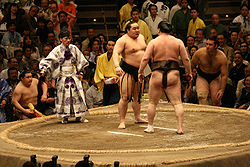- Mongols in Japan
-
Mongols in Japan 
Asashōryū Akinori and Hakuhō Shō glaring at each other Total population 4,753 (2007) Languages Japanese name Kanji 在日モンゴル人 Rōmaji Zainichi Mongorujin Mongolian name Cyrillic Япон дахь Монголчууд Romanisation Yapon dahi Mongolchuud There is a small community of Mongols in Japan, representing a minor portion of emigration from Mongolia. As of December 2008[update], there were 4,753 registered foreigners of Mongol nationality residing in Japan, according to the Ministry of Foreign Affairs, up from 2,545 in 2003.[1][2]
Contents
Sumo wrestlers
Starting in 1991, Mongols began to become especially dominant in sumo; as of 2005[update], Mongolians composed roughly 5% of all ranked sumo wrestlers, making them more than 60% (37 out of 61) of non-Japanese rikishi in Japan.[3][4] In a 2009 survey conducted by a Japanese statistical agency, of the four sumo wrestlers named as most famous by Japanese people, three were Mongols.[5]
Students
International students form a large proportion of the registered population of Mongolians in Japan.[6] The earliest Mongol exchange students, all three of them women, came to Japan in 1906, when Mongolia was still ruled by the Qing Dynasty.[7] Japan was also a popular destination for students from Mengjiang (in today's Inner Mongolia) in the late 1930s and early 1940s; among them were several who would go on to become famous scholars, such as Chinggeltei.[8][9] Japan and the Mongolian People's Republic officially agreed to send exchange students to each other in 1974; the first Mongol student to arrive under the agreement came in 1976. As of May 2006[update], 1,006 Mongol students were studying in Japanese institutions of higher education.[6]
Aside from Mongolian citizens, there were also estimated to be roughly 4,000 members of the Mongolian minority of China residing in Japan as of 2005[update]. Like migrants from Mongolia proper, they also came mostly on student visas, beginning in the 1990s; they were sponsored by professors of Mongol studies at Japanese universities. They are close-knit community; they reside mostly in the Nerima and Sugamo areas of Tokyo, and in many cases the same apartment has been occupied serially by successive migrants for more than a decade, with each passing the lease on to another migrant before leaving the country or moving on to different accommodation.[10]
Notable people
See also: Category:Mongolian sumo wrestlers- Asashōryū Akinori, originally Dolgorsuren Dagvadorj, sumo wrestler[11]
- Hakuhō Shō, originally Mönkhbatyn Davaajargal, sumo wrestler[12]
- Kyokutenhō Masaru, originally Tsebeknyam Nyamjyab, sumo wrestler[13]
- Kyokutenzan Takeshi, originally Enkhbat Batmunkh, sumo wrestler[14][15]
- Harumafuji Kōhei, originally Davaanyamyn Byambadorj, sumo wrestler[16]
See also
References
- ^ "モンゴル国", 『各国・地域情勢』, Tokyo, Japan: Ministry of Foreign Affairs, May 2005, http://www.mofa.go.jp/mofaj/area/mongolia/data.html, retrieved 2010-09-08
- ^ "統計表1", 『国籍(出身地)別 在留資格(在留目的)別 外国人登録者』, Tokyo, Japan: Ministry of Justice, 2003-05-30, http://www.moj.go.jp/PRESS/030530-1/030530-1-12.pdf, retrieved 2007-08-17
- ^ Wallace, Bruce (2005-02-27), "Beating Japanese wrestlers at their own game", San Francisco Chronicle, http://www.sfgate.com/cgi-bin/article.cgi?file=/c/a/2005/02/27/MNG31BGMTD1.DTL, retrieved 2007-09-05
- ^ Himmer, Alastair (2007-05-22), "Mongolians running amok in sumo", Reuters, http://www.reuters.com/article/sportsNews/idUST29908020070522, retrieved 2009-10-18
- ^ "Mongolians Most Famous in Japan", UB Post, 2009-08-21, http://ubpost.mongolnews.mn/index.php?option=com_content&task=view&id=3466&Itemid=46, retrieved 2009-10-18
- ^ a b 『留学生交流』, Mongolia: Embassy of Japan, http://www.mn.emb-japan.go.jp/jp/bunka/ryuugaku.htm, retrieved 2007-08-17
- ^ 横田 素子[YOKOTA Motoko] (2009), "1906年におけるモンゴル人学生の日本留学 [The first Mongolian students in Japan in 1906]", East West South North (15): 155–172, http://www.wako.ac.jp/souken/tozai/file/tz0926.pdf
- ^ 徐志民 [XU Zhimin], "抗战时期日本对蒙疆地区留日学生政策述 [Review of policies towards Mengjiang students studying in Japan during World War II]", Journal of Inner Mongolia University 38 (5), http://d.wanfangdata.com.cn/Periodical_nmgsfdxxb-zxshkxb200905008.aspx
- ^ "草原名人:开创蒙古语言研究黄金时期的清格尔泰 [Famous man of the plains: Chinggeltei, who pioneered the golden age of Mongolian language research]", People's Daily, 2007-07-19, http://politics.people.com.cn/GB/8198/85845/85850/88530/6006814.html, retrieved 2010-06-02
- ^ Le Bail, Hélène (September 2005), "The New Chinese Immigration to Japan: Between mobility and integration", China Perspectives (61), http://chinaperspectives.revues.org/document521.html
- ^ Frederick, Jim (2003-04-21), "Asian Heroes - Dolgorsuren Dagvadorj", Time Magazine, http://www.time.com/time/asia/2003/heroes/dolgorsuren_dagvadorj.html, retrieved 2007-08-17
- ^ "Hakuho hits sumo summit", Taipei Times, 2007-05-31, http://www.taipeitimes.com/News/sport/archives/2007/05/31/2003363281, retrieved 2009-11-01
- ^ "Bis in die Haarspitze" (in German), Der Spiegel, 2007-06-02, http://www.spiegel.de/sport/sonst/0,1518,486286,00.html, retrieved 2007-09-05
- ^ "Taka, Musashimaru win, set up all-yokozuna finale", Honolulu Star-Bulletin, 1999-11-20, http://starbulletin.com/1999/11/20/sports/sumo.html, retrieved 2007-09-05
- ^ "Mongolian striving to become top sumo wrestler", Japan Weekly Monitor, 2002-01-25, http://goliath.ecnext.com/premium/0199/0199-1492893.html, retrieved 2007-09-05
- ^ "Rising Mongolian star wins first sumo tournament", Agence France-Presse, 2009-05-24, http://www.google.com/hostednews/afp/article/ALeqM5jJdBKMZn7JJV5eg-AKHdQwQq1eGg, retrieved 2011-01-26
External links
- Mongolian Association in Japan
- Япон дахь Монгол Оюутны Холбоо (Union of Mongolian Students in Japan)
Immigration to Japan Americas Asia Bangladeshis · Burmese · Chinese · Filipinos · Indians · Indonesians · Iranians · Koreans · Mongolians · Nepalis · Pakistanis · Taiwanese · VietnameseOthers See also Dekasegi · Ethnic issues in Japan · Gaijin · Japanese nationality law · Foreign-born Japanese · FushūgakuCategories:- Ethnic minorities in Japan
- Japanese people of Mongolian descent
- Mongolian expatriates in Japan
Wikimedia Foundation. 2010.
